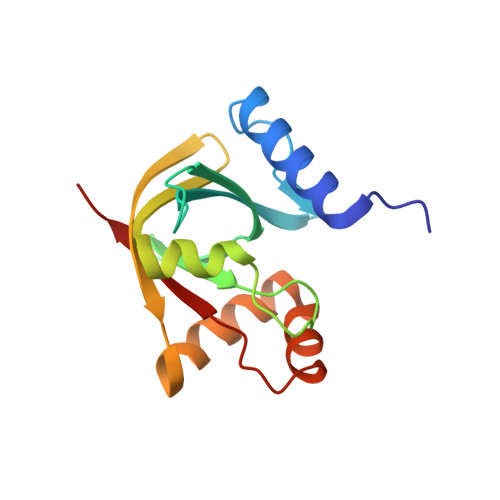Potency boost of a Mycobacterium tuberculosis dihydrofolate reductase inhibitor by multienzyme F 420 H 2 -dependent reduction.
Aragaw, W.W., Lee, B.M., Yang, X., Zimmerman, M.D., Gengenbacher, M., Dartois, V., Chui, W.K., Jackson, C.J., Dick, T.(2021) Proc Natl Acad Sci U S A 118
- PubMed: 34161270
- DOI: https://doi.org/10.1073/pnas.2025172118
- Primary Citation of Related Structures:
7KL8 - PubMed Abstract:
Triaza-coumarin (TA-C) is a Mycobacterium tuberculosis (Mtb) dihydrofolate reductase (DHFR) inhibitor with an IC 50 (half maximal inhibitory concentration) of ∼1 µM against the enzyme. Despite this moderate target inhibition, TA-C shows exquisite antimycobacterial activity (MIC 50 , concentration inhibiting growth by 50% = 10 to 20 nM). Here, we investigated the mechanism underlying this potency disconnect. To confirm that TA-C targets DHFR and investigate its unusual potency pattern, we focused on resistance mechanisms. In Mtb, resistance to DHFR inhibitors is frequently associated with mutations in thymidylate synthase thyA , which sensitizes Mtb to DHFR inhibition, rather than in DHFR itself. We observed thyA mutations, consistent with TA-C interfering with the folate pathway. A second resistance mechanism involved biosynthesis of the redox coenzyme F 420 Thus, we hypothesized that TA-C may be metabolized by Mtb F 420 -dependent oxidoreductases (FDORs). By chemically blocking the putative site of FDOR-mediated reduction in TA-C, we reproduced the F 420 -dependent resistance phenotype, suggesting that F 420 H 2 -dependent reduction is required for TA-C to exert its potent antibacterial activity. Indeed, chemically synthesized TA-C-Acid, the putative product of TA-C reduction, displayed a 100-fold lower IC 50 against DHFR. Screening seven recombinant Mtb FDORs revealed that at least two of these enzymes reduce TA-C. This redundancy in activation explains why no mutations in the activating enzymes were identified in the resistance screen. Analysis of the reaction products confirmed that FDORs reduce TA-C at the predicted site, yielding TA-C-Acid. This work demonstrates that intrabacterial metabolism converts TA-C, a moderately active "prodrug," into a 100-fold-more-potent DHFR inhibitor, thus explaining the disconnect between enzymatic and whole-cell activity.
Organizational Affiliation:
Center for Discovery and Innovation, Hackensack Meridian Health, Nutley, NJ 07110.

















